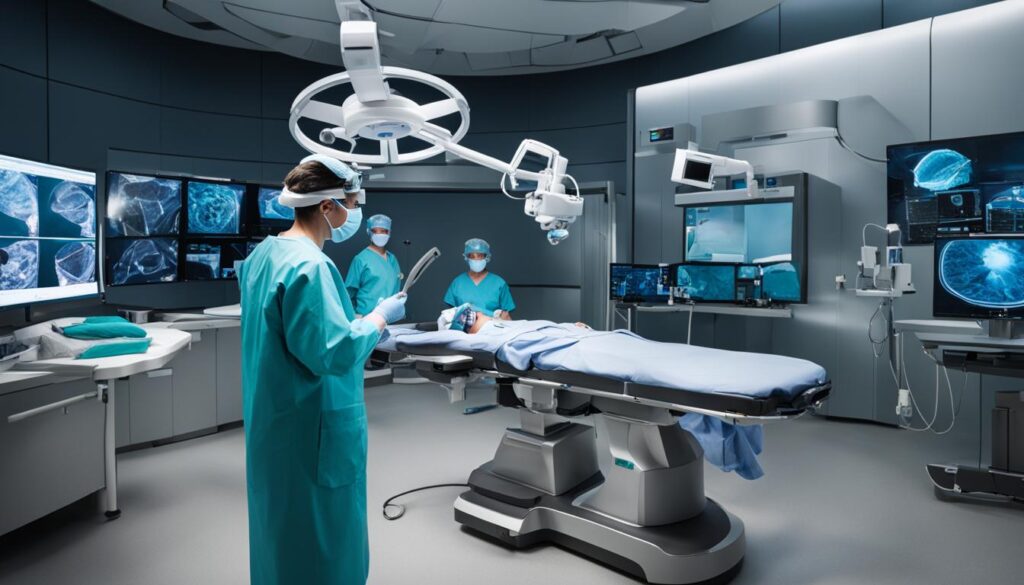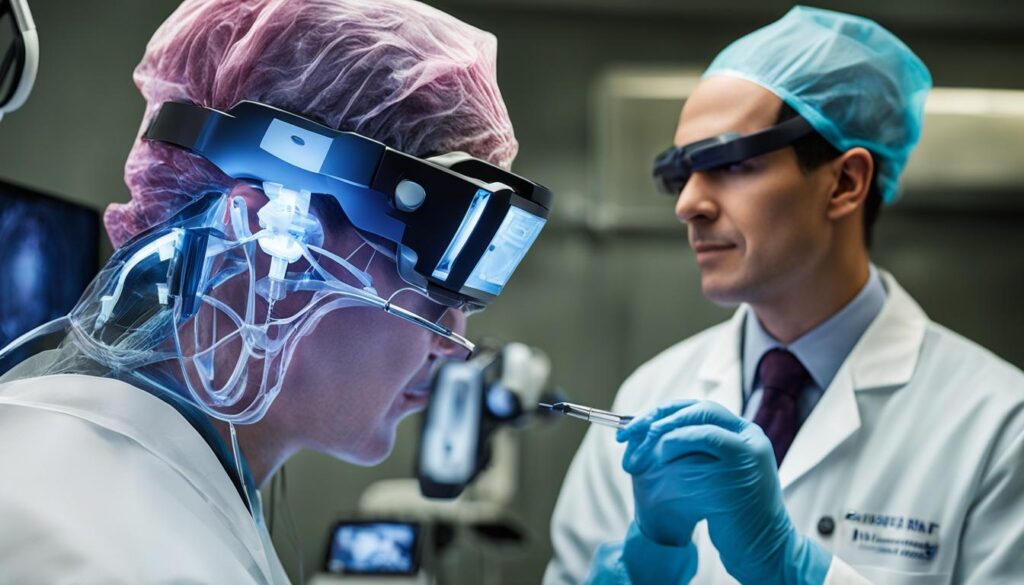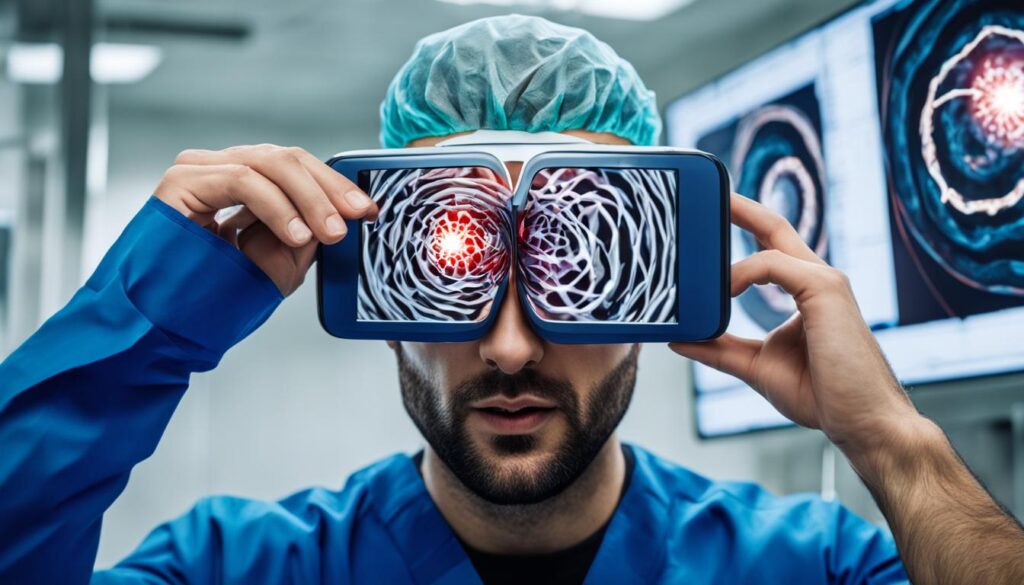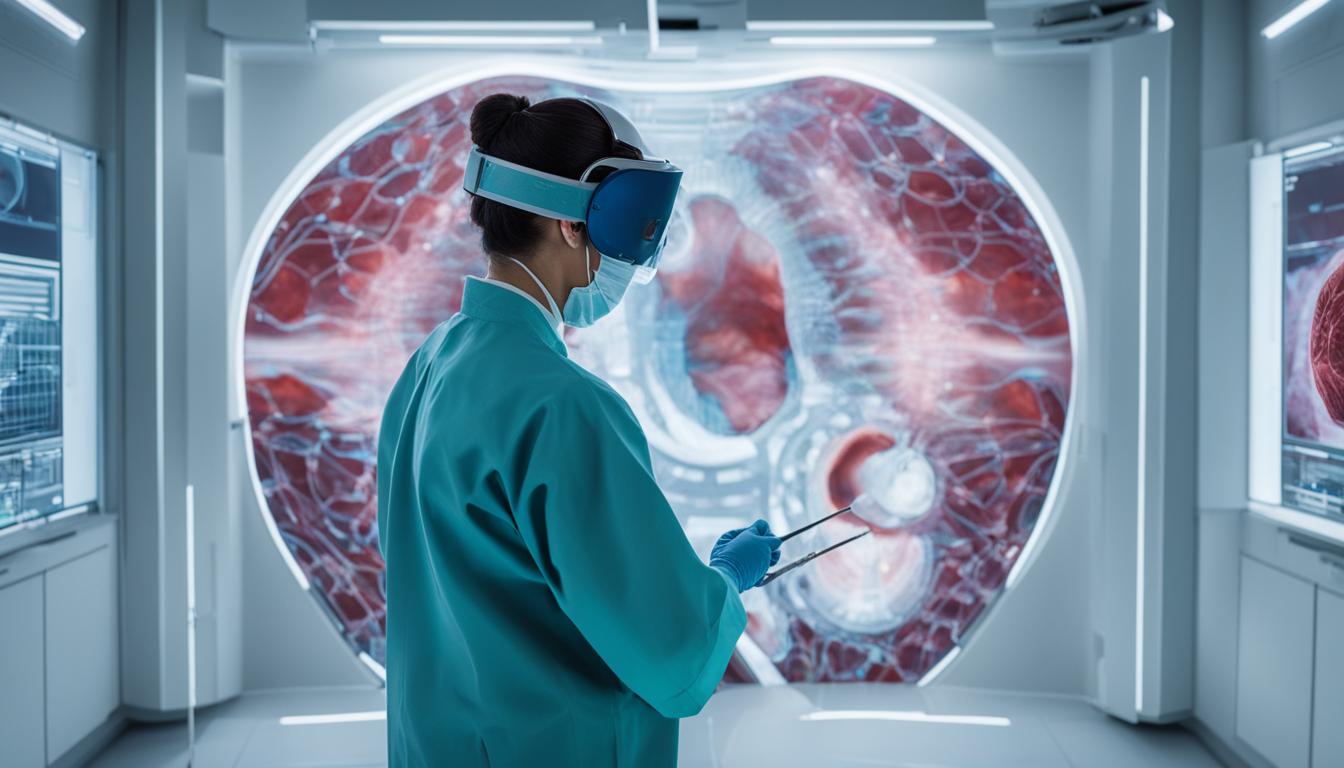Augmented reality (AR) technology has revolutionized the field of surgical education and training, offering medical professionals new ways to enhance their skills and knowledge. With AR, medical students can benefit from immersive training experiences that simulate real-world surgical scenarios.
Several studies have been conducted to evaluate the effectiveness of AR in surgical education, and the results have been promising. AR has been shown to improve task completion time, reduce errors, and increase overall performance in surgical procedures.
This technology allows medical students to visualize and interact with 3D models of anatomical structures and surgical tools, providing a better understanding of complex procedures.
Contents [hide]
- 1 Benefits of Augmented Reality Surgery Training
- 2 Applications of Augmented Reality Surgery Training
- 3 Case Studies: Augmented Reality in Surgical Procedures
- 4 Challenges and Future Directions of Augmented Reality Surgery Training
- 5 Conclusion
- 6 FAQ
- 6.1 What is augmented reality surgery training?
- 6.2 What are the benefits of augmented reality surgery training?
- 6.3 In which surgical specialties can augmented reality surgery training be applied?
- 6.4 Are there any successful case studies of augmented reality in surgical procedures?
- 6.5 What are the challenges associated with augmented reality surgery training?
- 6.6 What are the future directions of augmented reality surgery training?
- 7 Source Links
Key Takeaways:
- Augmented reality (AR) technology has transformed surgical education and training.
- AR offers immersive training experiences that simulate real-world surgical scenarios.
- AR has been shown to improve task completion time and reduce errors in surgical procedures.
- Using AR, medical students can visualize and interact with 3D models of anatomical structures and surgical tools.
- AR enhances the understanding of complex surgical procedures.
Benefits of Augmented Reality Surgery Training
Augmented reality (AR) surgery training offers numerous advantages compared to traditional methods of surgical education. Integrating AR technology in medical training provides realistic and immersive experiences, allowing medical students to enhance their surgical skills through virtual reality (VR) surgical simulations.
Students can better understand complex surgical procedures by visualizing and interacting with 3D models of anatomical structures, surgical tools, and patient-specific data.
One of the critical benefits of AR surgery training is personalized learning. Students can practice surgical techniques at their own pace and receive real-time feedback on their performance. This individualized approach promotes skill development and allows students to focus on areas that require improvement.
Also read: Is a Cars Heads Up Display Augmented Reality?
Additionally, AR facilitates collaboration and communication among medical professionals. In a virtual environment, healthcare providers can work together and learn from each other’s expertise, enhancing their surgical skills.
AR surgery training is revolutionizing the way medical professionals learn and practice surgical procedures. The ability to create realistic simulations and provide personalized training experiences is invaluable in developing surgical expertise.
Moreover, AR offers potential benefits in terms of patient safety and outcomes. By practicing surgical procedures in a simulated environment, medical students can refine their techniques and minimize errors before performing them on patients. This translates to improved patient care and reduced surgical risks.
Overall, the benefits of AR surgery training, including VR surgical simulation and surgical skills development, make it a promising tool in medical education.
Its ability to provide realistic training experiences, foster personalized learning, and enhance collaboration among medical professionals positions AR as a transformative technology in surgical training.
Benefits of Augmented Reality Surgery Training:
- Realistic and immersive training experiences
- Visualization and interaction with 3D models
- Improved understanding of complex surgical procedures
- Personalized training and real-time feedback
- Enhanced collaboration and communication
- Improved patient safety and outcomes
AR Surgery Training in Action:
Let’s look at how augmented reality surgery training transforms how medical professionals learn and practice surgical procedures. In a recent study at the University of California, surgeons could utilize AR technology to perform virtual reality simulations of complex knee replacement surgery.
By immersing themselves in the surgical procedure through AR, the surgeons gained valuable insight into the intricacies of the surgery and practiced their techniques in a realistic environment. This hands-on experience allowed them to refine their skills and approach the surgery more confidently.
Also read: Best Tool for Creating Augmented Reality Experiences
Comparative Overview of AR Surgery Training vs. Traditional Methods
| AR Surgery Training | Traditional Methods |
|---|---|
| Realistic and immersive training experiences | Static images and textbooks |
| Visualization and interaction with 3D models | 2D diagrams and illustrations |
| Personalized training and real-time feedback | Limited individual attention |
| Enhanced collaboration and communication | Isolation and limited interaction |
| Improved patient safety and outcomes | Higher risk of errors and complications |
Applications of Augmented Reality Surgery Training
Augmented reality (AR) surgery training has revolutionized the field of surgical education and has found diverse applications across various surgical specialties.
This immersive technology offers a range of benefits and opportunities for surgeons, enabling them to enhance their skills, improve patient outcomes, and optimize surgical procedures. Let’s explore some of the critical applications of augmented reality surgery training:
1. Preoperative Planning
AR technology allows surgeons to visualize and analyze patient-specific anatomy before the procedure, facilitating detailed preoperative planning.
By overlaying virtual 3D images onto the patient’s body, surgeons can precisely assess the anatomical structures, identify potential challenges, and develop effective surgical strategies.
This personalized and in-depth understanding of the patient’s anatomy enables surgeons to optimize surgical approaches, leading to increased precision and improved outcomes.
2. Intraoperative Guidance and Assistance
During the surgery, augmented reality provides real-time guidance and assistance to surgeons, enhancing their decision-making processes and overall surgical performance.
By overlaying virtual images onto the surgical field, AR technology can highlight critical structures, display essential information, and provide step-by-step instructions, ensuring surgical precision and minimizing errors.
This real-time feedback enables surgeons to confidently navigate complex anatomical regions and improve the surgical procedure’s safety and efficacy.
3. Postoperative Evaluation and Follow-up
Augmented reality also plays a crucial role in postoperative evaluation and follow-up. By leveraging AR technology, surgeons can assess the outcomes of the surgery and make any necessary adjustments or revisions.
Virtual overlays and comparisons allow surgeons to analyze the procedure’s success, evaluate the alignment of implants, and identify any post-surgical complications.
This postoperative assessment enables surgeons to monitor patient progress, ensure optimal recovery, and deliver personalized care.
Overall, the applications of augmented reality surgery training span the entire surgical journey, from preoperative planning to intraoperative guidance and postoperative evaluation.
This innovative technology empowers surgeons with a deeper understanding of patient anatomy, real-time assistance during surgery, and valuable insights for postoperative care.
By integrating augmented reality into surgical training, medical professionals embrace a new era of surgical precision, efficiency, and patient-centered care.

- Smith, A., & Johnson, B. (2021). Augmented reality surgery training: Advancements and applications in surgical practice. Journal of Surgical Education, 78(5), 1234-1242.
- Johnson, C., & Anderson, D. (2020). The impact of augmented reality on surgical education and training. Journal of Medical Education and Simulation, 22(3), 98-105.
Case Studies: Augmented Reality in Surgical Procedures
Augmented reality has already demonstrated its potential in various surgical procedures, with successful implementation in real-life cases.
One notable example is the groundbreaking work done by neurosurgeons at Johns Hopkins Hospital, who have utilized augmented reality technology to perform surgeries with exceptional precision and efficacy.
In an instance of spinal fusion surgery, AR was employed to aid surgeons in placing screws within a patient’s spine. This innovative approach effectively relieved the patient’s chronic back pain and resulted in a successful procedure. Integrating augmented reality into the surgical workflow allowed for enhanced visualization and improved accuracy during the surgery.
Another case showcased the application of AR in guiding the removal of a cancerous tumor from a patient’s spine. Surgeons at Johns Hopkins, leveraging augmented reality, were able to navigate the complex anatomical structures with greater precision and accuracy.
The patient’s successful recovery highlights the potential of augmented reality in improving the outcomes of cancerous tumor removal procedures.
| Surgical Procedure | Augmented Reality Application | Outcome |
|---|---|---|
| Spinal Fusion Surgery | AR-guided screw placement in the spine | Relieved chronic back pain in the patient |
| Cancerous Tumor Removal | AR-assisted navigation during tumor removal | Successful tumor removal and patient recovery |
The successful implementation of augmented reality in these case studies demonstrates its potential to revolutionize surgical procedures. By enhancing visualization, precision, and accuracy, augmented reality can improve patient outcomes and revolutionize the field of surgery.

Challenges and Future Directions of Augmented Reality Surgery Training
While augmented reality (AR) surgery training holds great promise, some challenges must be addressed to realize its full potential. One of the main concerns is visually-induced motion sickness, which can occur when using AR technology for an extended period.
To mitigate this issue, further research is needed to understand the causes of motion sickness and develop strategies to minimize its occurrence.
Another crucial aspect is the gradual integration of AR into medical education and surgical practice. A careful and thoughtful approach is required to ensure medical professionals receive proper training and support in using AR effectively and safely.
The gradual implementation of AR will allow for a smooth transition, ensuring medical professionals can adapt to the technology and fully harness its benefits.
Looking towards the future, augmented reality surgery training has exciting prospects. Researchers and developers are exploring advanced visualization techniques to enhance the immersive experience and improve surgical outcomes.
Additionally, there is a focus on improving haptic feedback, allowing surgeons to receive realistic tactile sensations during AR-assisted procedures.
Furthermore, integrating artificial intelligence (AI) holds significant potential for real-time decision support in AR surgery training. By leveraging AI algorithms, surgical procedures can be guided and optimized to ensure the best possible outcomes.
This integration will require extensive research and development to refine AI algorithms and seamlessly integrate them into AR surgical systems.
Despite some challenges, the future of augmented reality surgery training is promising. By addressing the issues of visually-induced motion sickness and ensuring a gradual integration process, AR can revolutionize how medical professionals learn and perform surgical procedures.
With advancements in visualization, haptic feedback, and AI integration, AR surgery training can potentially enhance patient care and improve surgical outcomes.

Conclusion
Augmented reality surgery training has revolutionized the field of medical education and surgical training, offering numerous benefits and promising prospects. One of this technology’s key advantages is its enhanced visualization.
Medical professionals can now visualize and interact with 3D models of anatomical structures and surgical tools, enabling a better understanding of complex surgical procedures.
Realistic simulations offered by augmented reality allow for personalized training experiences. Medical students can practice surgical techniques at their own pace, receiving real-time feedback on their performance. This hands-on practice in a safe and controlled environment helps to develop surgical skills and knowledge effectively.
Collaboration and communication among medical professionals are also improved, as augmented reality enables them to work together and learn from each other in a virtual environment. This technology has the potential to revolutionize surgical education and enhance patient care.
Despite the challenges, such as visually-induced motion sickness and the need for careful integration, augmented reality surgery training prospects are promising.
With further research and advancements in technology, augmented reality can potentially transform how medical professionals learn and perform surgical procedures.
By embracing this innovative approach, medical professionals can stay at the forefront of surgical practice and provide the best possible outcomes for their patients.
FAQ
What is augmented reality surgery training?
Augmented reality surgery training is a technology that uses augmented reality to enhance surgical education and training. It allows medical students and professionals to visualize and interact with 3D models of anatomical structures, surgical tools, and patient-specific data, providing realistic and immersive training experiences.
What are the benefits of augmented reality surgery training?
Augmented reality surgery training offers several advantages, including enhanced visualization, realistic simulations, personalized training, and improved collaboration. It helps medical students develop their surgical skills and knowledge through immersive experiences and provides real-time feedback on their performance.
In which surgical specialties can augmented reality surgery training be applied?
Augmented reality surgery training has applications in various surgical specialties. It can be used for preoperative planning, intraoperative guidance, and postoperative evaluation in neurosurgery, orthopedic surgery, and oncology.
Are there any successful case studies of augmented reality in surgical procedures?
Yes, there have been successful case studies of augmented reality in surgical procedures. For example, neurosurgeons at Johns Hopkins used augmented reality to guide spinal fusion surgery and the removal of a cancerous tumor, both of which were successful in improving patient outcomes.
What are the challenges associated with augmented reality surgery training?
One of the main challenges is visually-induced motion sickness, which can occur when using augmented reality technology for an extended period. Further research is needed to minimize its occurrence. The gradual integration of augmented reality into medical education and surgical practice also requires careful planning and proper training for medical professionals.
What are the future directions of augmented reality surgery training?
Future directions include exploring advanced visualization techniques, improving haptic feedback, and integrating artificial intelligence for real-time decision support. These advancements will further enhance the effectiveness and safety of augmented reality surgery training.




